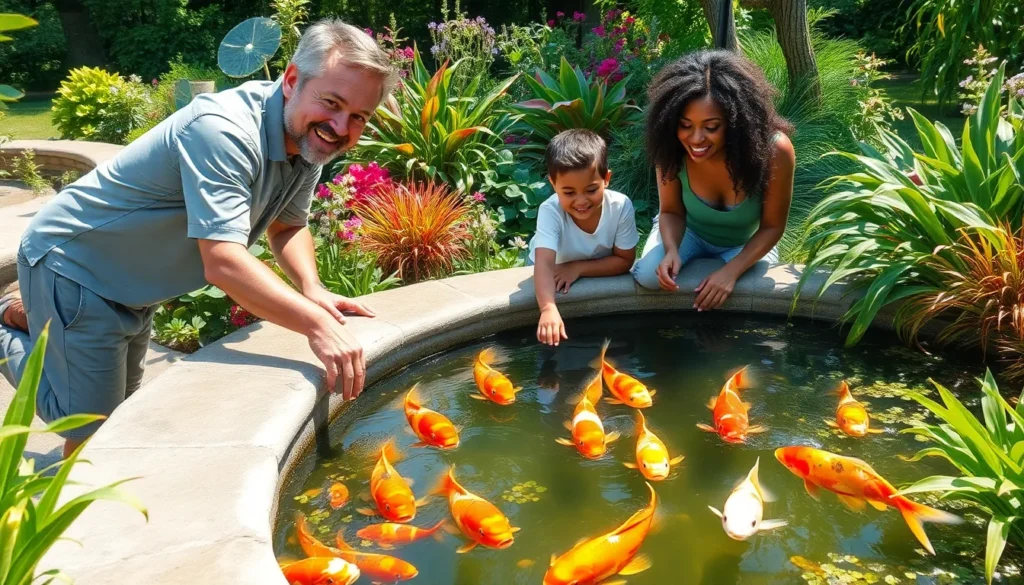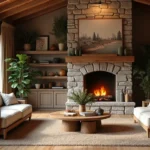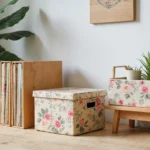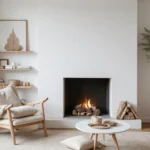We’ve all dreamed of transforming our outdoor space into a tranquil oasis where the gentle sound of water creates the perfect backdrop for relaxation. A well-designed pond doesn’t just add visual appeal to your industry – it becomes the centerpiece that draws family and friends together while providing a haven for local wildlife.
Whether you’re working with a sprawling backyard or a cozy patio space we’ll show you how to create the perfect water feature that fits your vision and budget. From sleek modern designs with clean lines to naturalistic ponds that blend seamlessly into your garden’s network there’s a style that’ll complement every home.
Ready to jump into the industry of pond possibilities? We’re about to explore creative designs maintenance tips and essential features that’ll help you build the stunning water feature you’ve always wanted. Your dream pond is closer than you think.
Natural Wildlife Pond Ideas for Eco-Friendly Gardens
Natural wildlife ponds transform your garden into a thriving network that supports local biodiversity. These eco-friendly water features create sustainable habitats while reducing your environmental footprint.
Creating Shallow Areas for Birds and Small Animals
Design graduated depths ranging from 2 inches at the edges to 18 inches in deeper zones to accommodate various wildlife species. Birds prefer shallow water between 1-3 inches deep for drinking and bathing, while amphibians like frogs and toads need gradual slopes for easy access.
Install gentle sloping beaches using natural materials like pebbles, sand, or packed earth to create comfortable entry points. We recommend creating multiple shallow zones around 20-30% of your pond’s perimeter to maximize wildlife accessibility.
Add partially submerged logs or flat stones that serve as resting platforms for small mammals, reptiles, and insects. These features provide crucial stepping stones and basking spots that encourage diverse wildlife visits throughout the day.
Position shallow areas on the south-facing side of your pond where morning sun creates warm, inviting conditions for wildlife activity. This strategic placement helps maintain optimal water temperatures for amphibian breeding and insect development.
Incorporating Native Aquatic Plants
Select emergent plants like cattails, arrowhead, and pickerel rush that grow with roots underwater and foliage above the surface. These native species provide nesting sites for waterfowl and cover for fish while naturally filtering pond water.
Plant submerged oxygenators such as hornwort, cabomba, and vallisneria that release oxygen during photosynthesis and absorb excess nutrients. We suggest covering 30-50% of your pond’s surface area with these underwater plants to maintain healthy water chemistry.
Include floating plants like water lilies, lotus, and spatterdock that shade the water surface and reduce algae growth. Native floating species create landing pads for insects and provide shelter for fish and amphibians beneath their broad leaves.
Establish marginal plants around your pond’s perimeter using species like blue flag iris, cardinal flower, and marsh marigold. These wetland natives extend your pond’s network into the surrounding industry while attracting butterflies, hummingbirds, and beneficial insects.
Building Natural Rock Formations and Edges
Stack local fieldstone to create irregular, natural-looking borders that blend seamlessly with your garden’s existing industry. We recommend using stones of varying sizes, with larger boulders as anchors and smaller rocks filling gaps for authentic appeal.
Construct underwater rock piles that serve as fish habitat and spawning areas while providing surfaces for beneficial bacteria colonization. These submerged structures should occupy 10-15% of your pond’s bottom area to maximize ecological benefits.
Design cascading rock features that create gentle waterfalls or streams feeding into your main pond area. Natural stone arrangements help oxygenate water while producing soothing sounds that mask urban noise pollution.
Build rock crevices and caves using flat stones to create hiding spots for fish, amphibians, and aquatic insects. These sheltered areas provide protection from predators and extreme weather while supporting year-round wildlife populations.
Koi Pond Ideas for Stunning Water Features
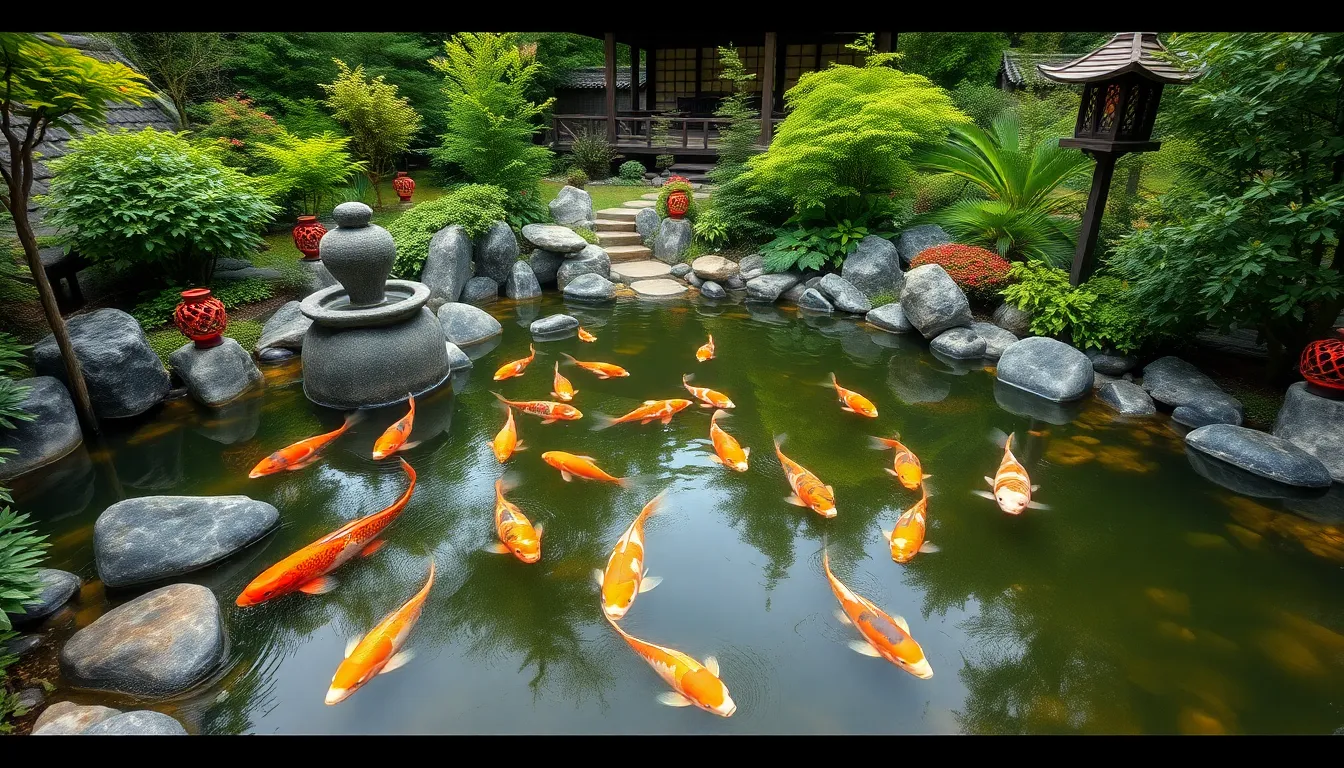
Creating a koi pond transforms your garden into a living masterpiece that combines aesthetic beauty with aquatic life. These specialized water features require careful planning to ensure both visual appeal and optimal fish health.
Designing Proper Filtration Systems
Building an effective filtration system forms the foundation of any successful koi pond. Mechanical filtration removes debris and waste particles that cloud water and compromise fish health. We recommend installing skimmer boxes and settling chambers to capture leaves, uneaten food, and fish waste before they decompose.
Biological filtration converts harmful ammonia into harmless compounds through beneficial bacteria colonies. These bacteria naturally develop in filter media like bio balls, ceramic rings, and lava rock. Establishing this biological balance typically takes 4-6 weeks in new pond installations.
Chemical filtration removes impurities and excess nutrients that promote algae growth. Activated carbon filters eliminate chlorine and organic compounds, while UV sterilizers destroy harmful bacteria and algae spores. Installing these systems in sequence creates multiple barriers against water quality issues.
Selecting Compatible Koi Fish Varieties
Choosing the right koi varieties ensures peaceful coexistence and optimal pond aesthetics. Standard koi like Kohaku, Sanke, and Showa grow 18-24 inches and thrive in ponds deeper than 4 feet. Butterfly koi with flowing fins require gentler water circulation to prevent damage to their delicate appendages.
Matching fish size to pond capacity prevents overcrowding stress. We calculate one koi per 250-500 gallons of water depending on adult fish size and filtration capacity. Introducing similar sized fish reduces territorial disputes and feeding competition.
Temperature compatibility plays a crucial role in variety selection. Cold hardy varieties like Asagi and Shusui tolerate winter temperatures down to 35°F, while ornamental varieties need heated indoor environments during freezing months.
Adding Japanese-Inspired Elements
Incorporating authentic Japanese design elements creates a serene garden sanctuary around your koi pond. Natural materials like weathered wood, river stones, and bamboo establish the foundational aesthetic of traditional Japanese water gardens. These materials age gracefully and develop character over time.
Stone arrangements follow traditional principles of asymmetrical balance and natural groupings. Large anchor stones provide stability while smaller accent stones create visual interest and fish hiding spots. Positioning stones at odd numbered groupings of 3, 5, or 7 follows classical Japanese design philosophy.
Water features like bamboo fountains and stone waterfalls add movement and sound to create meditative environments. Installing these elements at varying heights generates different water sounds from gentle trickling to robust cascading. Decorative lanterns and carefully pruned plants complete the authentic Japanese garden experience around your koi pond.
Small Backyard Pond Ideas for Limited Spaces
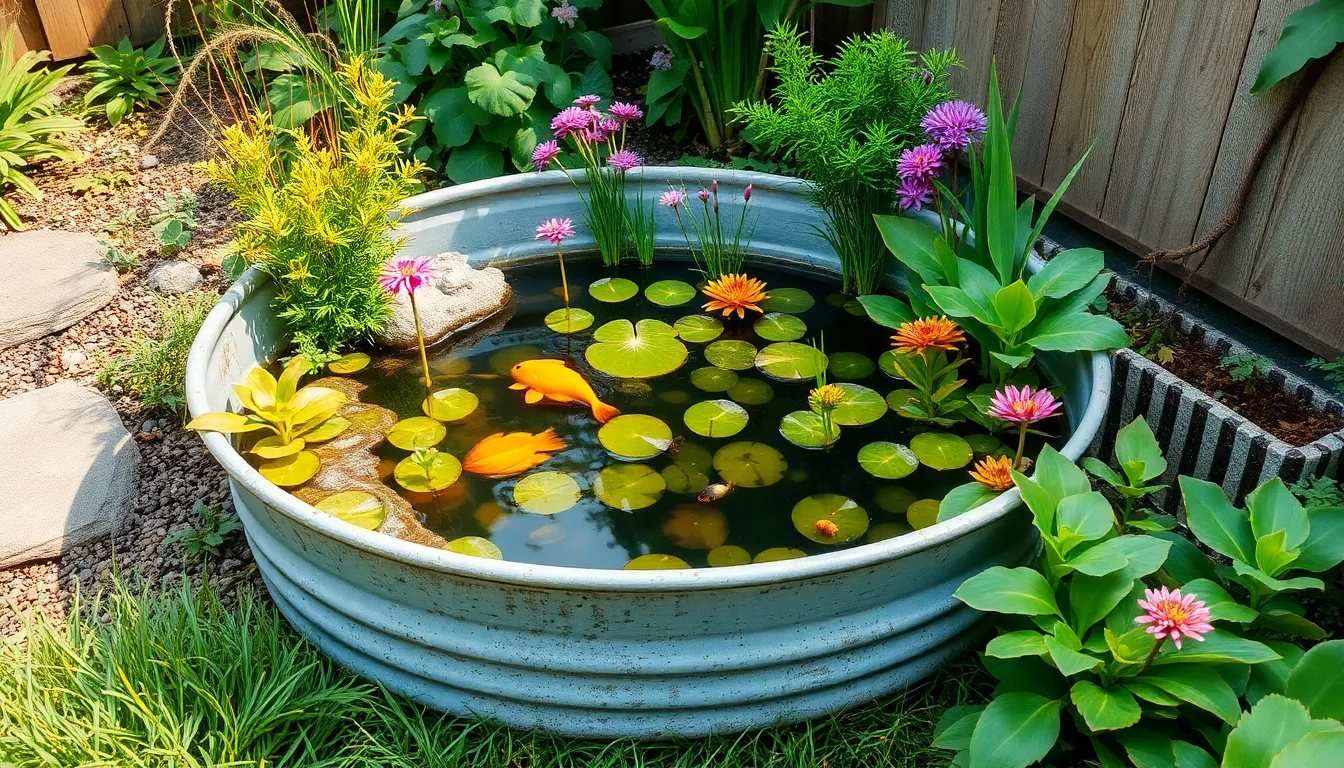
When space is limited, we can still create stunning water features that maximize every square foot. Small backyard ponds offer endless possibilities for transforming compact areas into tranquil retreats.
Container Pond Answers
Barrel ponds transform old barrels or large tubs into charming water features perfect for tiny spaces. We recommend ensuring the ground stays level and using a pond liner with a mini-pump for proper water circulation.
Miniature ponds in sinks or basins repurpose old ceramic fixtures into delightful aquatic displays. Sealing any drainage holes with waterproof putty creates a watertight container ready for aquatic plants like hornwort and small water lilies.
Galvanized tubs provide rustic charm while offering durability and easy maintenance. These containers work exceptionally well for creating themed pond displays that complement farmhouse or industrial garden styles.
Corner Pond Designs
Rounded corner installations integrate seamlessly into existing garden layouts using small, curved shapes that fit snugly into tight spaces. This design approach maximizes water surface area while maintaining accessibility from multiple angles.
Triangular pond configurations use corner spaces more efficiently than traditional rectangular designs. We’ve found these angular shapes create visual interest while providing adequate swimming space for small fish.
Tiered corner features stack multiple levels to create cascading water effects in minimal footprints. These installations add vertical dimension to corner spaces while producing soothing water sounds.
Raised Pond Installations
Elevated brick ponds create visually appealing and accessible water features using traditional masonry techniques. Building with bricks or stones helps integrate the pond into surrounding landscapes while providing comfortable viewing heights.
Container raised ponds use elevated planters or custom-built platforms to create manageable water features. This method allows easier maintenance access and integrates beautifully into various garden styles.
Deck-mounted installations extend living spaces by incorporating ponds directly into outdoor platforms. We recommend reinforcing deck structures to support water weight while creating seamless transitions between hardscape and water features.
Modern Pond Ideas with Contemporary Design Elements
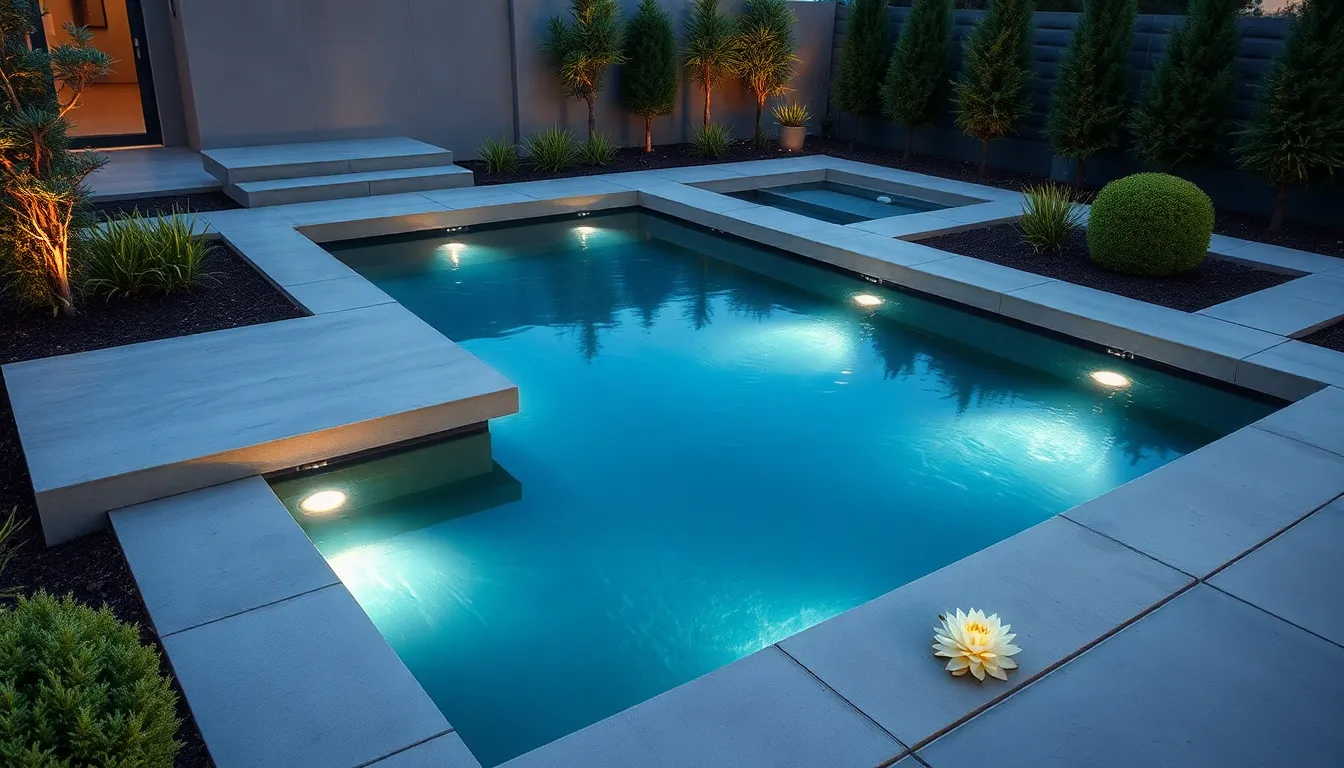
Contemporary pond design takes a bold departure from traditional curved water features, embracing architectural precision and sleek aesthetics. These modern installations create stunning focal points that complement today’s minimalist outdoor living spaces.
Geometric Shapes and Clean Lines
Rectangular and square pond configurations form the foundation of contemporary water feature design. We create these structures using poured concrete walls with straight edges and right angles, often leaving them uncapped for that sleek, industrial finish. Multi-level terraced ponds add architectural drama as water spills smoothly from one geometric level to the next.
Interconnecting squares or rectangles produce visually striking effects when arranged in thoughtful patterns across your industry. These geometric forms work exceptionally well when integrated with modern hardscaping elements like gravel paths and stone accents.
Floating stepping stones in square or rectangular shapes can be arranged in linear pathways across the water’s surface. This design element enhances both function and visual appeal while maintaining the pond’s geometric integrity.
LED Lighting Integration
Subtle LED strip lighting transforms modern ponds into dramatic nighttime features that showcase their architectural beauty. We strategically place these energy-efficient lights along pond edges and beneath the water’s surface to create stunning reflective effects.
Dark or inky black pond liners work in perfect harmony with LED lighting systems to produce mirror-like water surfaces. This combination creates depth and drama while highlighting the pond’s clean geometric lines after sunset.
Spotlights positioned strategically can illuminate accompanying sculptures or decorative elements without overwhelming the pond’s minimalist design. The key lies in achieving subtle illumination that enhances rather than dominates the overall aesthetic.
Minimalist Plant Selection
Low-maintenance sculptural plants serve as the preferred vegetation choice for contemporary pond designs. We recommend clipped box hedges positioned around the pond’s perimeter to maintain those crisp geometric lines while adding organic texture.
Select water plants like water lilies provide the only aquatic vegetation needed to complement modern pond aesthetics. This minimal approach ensures the dark water and architectural elements remain the primary visual focus.
Decorative accents such as stainless steel or mirrored globes can replace excessive plantings while catching light and complementing the minimalist style. These elements add visual interest without cluttering the pond’s clean design philosophy.
DIY Pond Ideas for Budget-Conscious Homeowners

Building a stunning pond doesn’t require very costly. We’ll show you how to create beautiful water features using affordable materials and techniques that deliver professional results without the high costs.
Using Recycled Materials and Containers
Repurposed tires offer one of the most cost-effective pond bases available. Multi-basin ponds can be created using a set of used tires in various sizes, with each tire dug into the ground to form cascading water features. We recommend starting with larger tires as foundation elements and gradually incorporating smaller ones for visual depth.
Old boats and plastic containers provide ready-made pond structures that eliminate excavation costs. Wooden boats work exceptionally well for container ponds in small spaces since they’re easily moved or updated when needed. Large plastic tubs and bins serve as excellent alternatives for homeowners seeking portable water features.
Basic preparation materials like sand, newspaper, or old carpet create protective barriers before liner installation. These common household items cushion the container bottom and prevent punctures while keeping project expenses minimal. We’ve found that layering these materials provides extra protection without important cost increases.
Simple Liner Installation Techniques
Affordable pond liners are readily available from local suppliers and discount stores at fraction of specialty retailer prices. After roughing out your pond area, we recommend shopping around for flexible liners that offer durability without premium pricing. Quality doesn’t always require expensive materials when installation techniques are properly executed.
Protective base layers using sand or newspaper create essential barriers between ground surfaces and liner materials. This method prevents rocks and roots from puncturing expensive liner investments while ensuring long-term durability. We suggest applying generous amounts of cushioning material for maximum protection.
Edge securing techniques with rocks and natural materials provide professional finishing touches at minimal expense. Heavy stones around pond perimeters hold liners securely in place while creating attractive borders. This approach eliminates costly edge treatments while maintaining aesthetic appeal and functional integrity.
Low-Maintenance Plant Options
Hardy water lilies thrive in most climates while requiring minimal ongoing care throughout growing seasons. These floating plants help filter water naturally and reduce algae growth without expensive filtration systems. We’ve observed that established lily colonies create stunning visual displays with virtually no maintenance requirements.
Native marginal plants adapt easily to local conditions and provide excellent wildlife habitat benefits. Papyrus and similar species filter water effectively while supporting birds and beneficial insects around pond edges. Selecting locally adapted varieties ensures successful establishment with reduced watering and fertilization needs.
Floating plants like duckweed offer rapid coverage and natural filtration capabilities at extremely low costs. These fast-growing species control algae while requiring zero planting or root establishment procedures. We recommend monitoring growth rates since successful floating plants can multiply quickly in favorable conditions.
| DIY Pond Idea | Materials Needed | Maintenance Level |
|---|---|---|
| Recycled Tire Pond | Used tires, liner, rocks | Low |
| Container Pond | Boat/plastic tub, liner, rocks | Low |
| Liner Pond | Sand/newspaper, liner, rocks | Low |
| Low-Maintenance Plant Selection | Native plants, lilies, duckweed | Very Low |
Waterfall Pond Ideas for Dynamic Water Movement
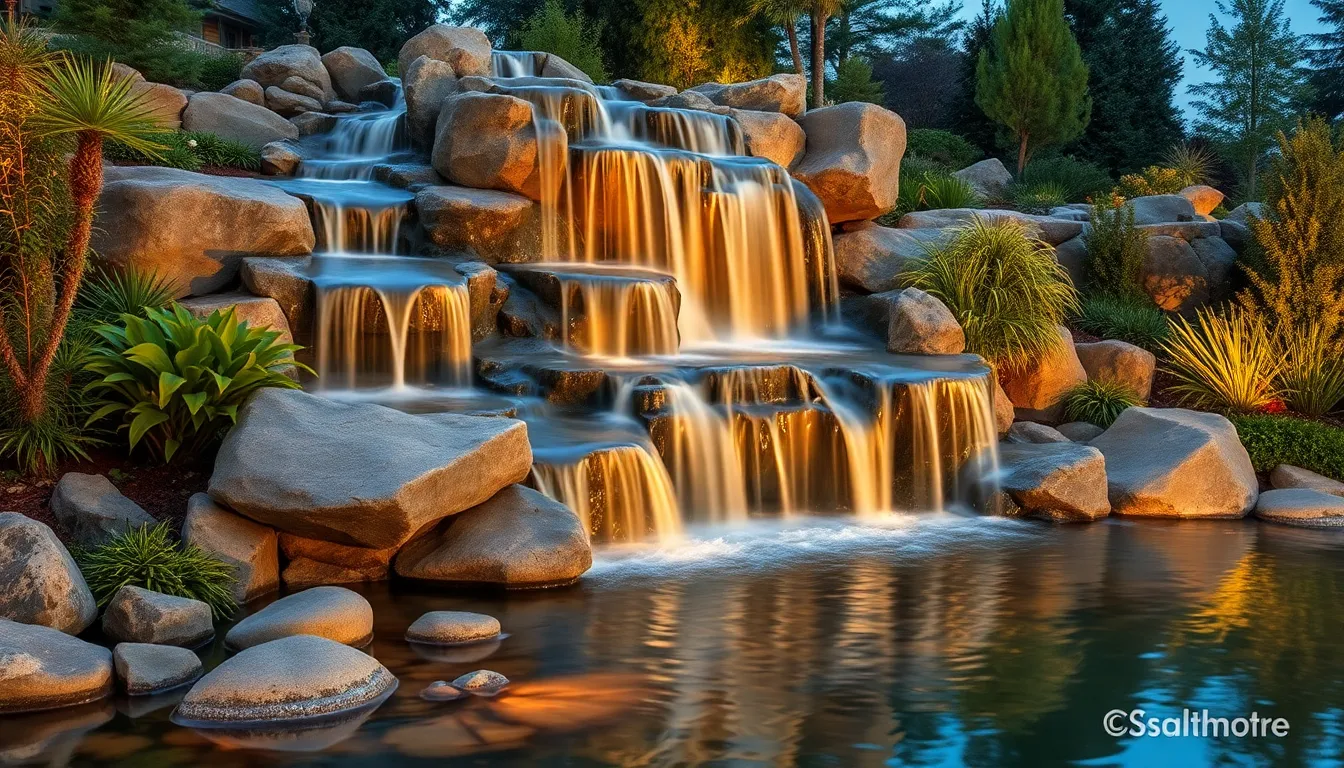
Waterfalls transform static ponds into vibrant ecosystems that capture attention with their mesmerizing movement and soothing sounds. These ever-changing features not only enhance visual appeal but also improve water quality through increased oxygenation and circulation.
Multi-Tiered Cascading Systems
Creating vertical water flow through stacked levels adds drama and functionality to your pond design. Multiple tiers allow water to cascade in stages, generating natural oxygenation that keeps your pond healthy and clear. Each level can be constructed at different heights using rocks or manufactured ledges to guide water flow smoothly from one stage to the next.
Dual waterfall boxes maximize the impact of your cascading system. These specialized components direct water over several drops, amplifying both visual interest and the relaxing sounds that make waterfall ponds so appealing. Small backyard ponds benefit from compact multi-tier designs, while larger industry features can accommodate more elaborate cascading arrangements.
Positioning each tier strategically ensures optimal water distribution and flow patterns. The upper levels should channel water effectively to lower sections, creating a continuous cascade that maintains momentum throughout the entire system. This approach works equally well for both intimate garden settings and expansive outdoor spaces.
Natural Stone Waterfall Construction
Selecting the right stones creates the foundation for a durable and visually stunning waterfall. Granite boulders and Missouri Moss rock provide excellent stability and natural beauty that blends seamlessly with surrounding landscapes. These materials withstand weather conditions while maintaining their appearance for years.
Balancing flat and round stones optimizes both function and aesthetics in your waterfall design. Flat stones positioned at each drop’s lip distribute water evenly across the surface, preventing erosion and creating smooth water flow. Round stones work perfectly for edging and structural support, adding natural texture and visual interest.
Blending your stone waterfall with the surrounding environment requires thoughtful plant placement and soil integration. Native plants soften the transitions between hardscape and industry, while strategic soil placement creates natural-looking edges. This approach ensures your waterfall appears as if it’s always been part of your garden’s network.
Pump and Circulation Planning
Sizing your pump correctly ensures optimal performance and water movement throughout your waterfall system. The pump must handle both the desired flow rate and the vertical height of your waterfall structure. Undersized pumps struggle to maintain consistent flow, while oversized units waste energy and create excessive turbulence.
Strategic pump placement protects your system from debris and maintains water clarity. Position the intake away from areas where leaves and organic matter typically collect, ensuring consistent water circulation. Adequate filtering prevents clogs and extends pump life significantly.
Recirculating systems offer low maintenance answers that fit various outdoor spaces. Pondless waterfalls are growing in popularity because they require minimal upkeep while delivering maximum visual and auditory impact. These systems work particularly well in smaller yards where traditional pond construction might be challenging.
Golden LED lighting integrated into your circulation system creates dramatic nighttime effects. Illuminated waterfalls become stunning focal points after dark, extending your outdoor enjoyment well into the evening hours. Strategic light placement enhances water movement while highlighting the natural beauty of your stone construction.
Indoor Pond Ideas for Year-Round Enjoyment
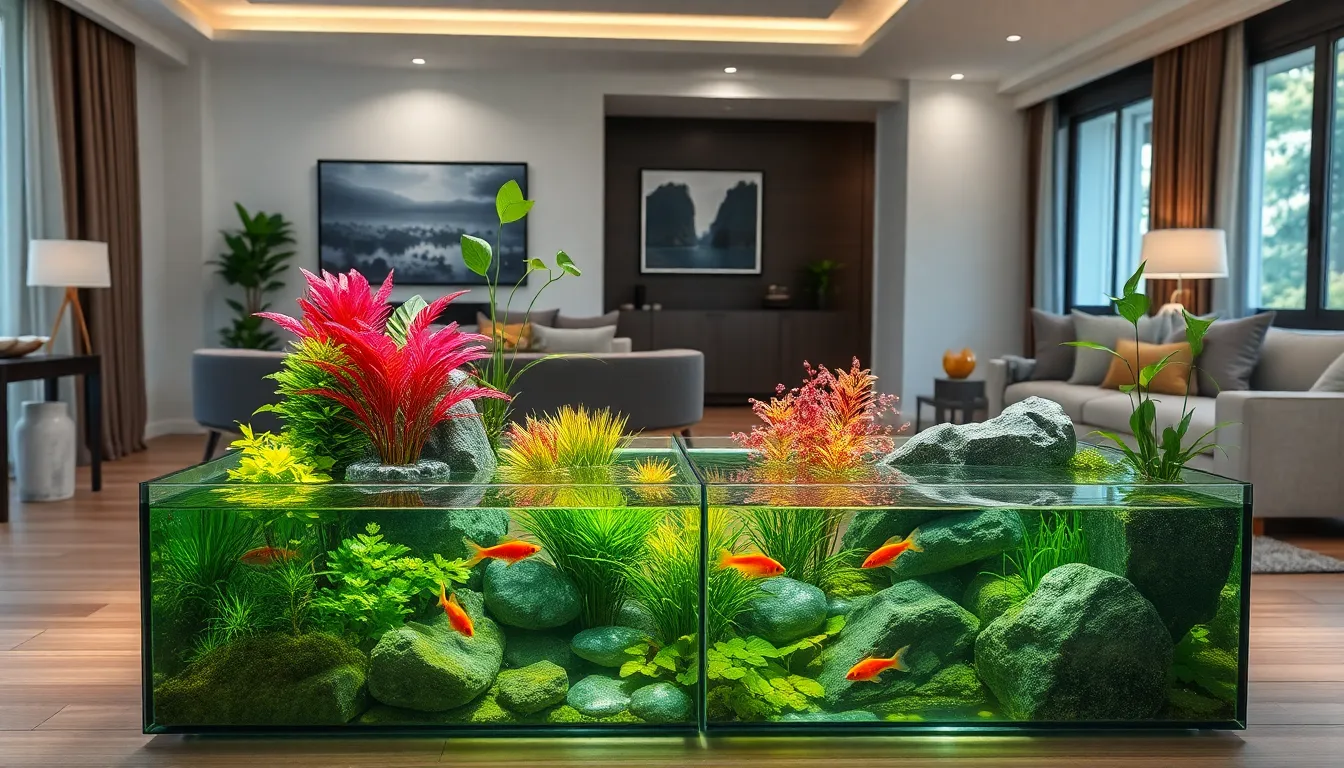
Indoor ponds let us enjoy water features regardless of weather conditions while providing therapeutic benefits and visual interest throughout every season.
Greenhouse Pond Installations
Greenhouse pond installations combine controlled environments with natural sunlight to create thriving aquatic ecosystems. We can design these setups to range from small water gardens to large ponds that accommodate both ornamental fish and aquatic plants. Fish and aquatic plants benefit from consistent temperatures and sunlight exposure, which reduces our need for artificial lighting and heating systems.
Integrated filtration systems maintain water quality automatically in greenhouse environments. Natural light exposure helps plants photosynthesize effectively while supporting diverse aquatic life. We’ll find that greenhouse ponds create ideal conditions for year-round fish keeping and plant cultivation without weather-related disruptions.
Basement Water Garden Setups
Basement water garden setups provide stable temperatures and ample space for large or custom water features in our homes. We can create everything from simple tub ponds to elaborate installations with waterfalls, rock formations, and advanced filtration systems. Stable underground temperatures make basements perfect locations for maintaining consistent water conditions.
Sufficient lighting becomes essential in basement installations since natural sunlight is limited. Ventilation systems prevent humidity buildup while humidity control prevents mold growth around our water features. We should plan for proper drainage and waterproofing to protect our basement foundations from potential water damage.
Living Room Feature Ponds
Living room feature ponds serve as striking design elements that transform our interior spaces into tranquil retreats. Glass topped tables with submerged aquatic features create modern focal points while freestanding ponds offer minimalist or ornate design options. We can choose materials like glass aquariums for clear fish viewing or stone and wooden finishes that blend with our existing decor.
Plants like manjula pothos coexist beautifully with fish while UV sterilizers help us control algae growth effectively. Safety precautions such as higher edges or protective netting prevent fish from jumping out of our indoor ponds. LED lighting enhances visual appeal during evening hours while supporting healthy plant growth throughout the day.
Regular maintenance including frequent water changes and proper filtration keeps our living room ponds healthy and attractive. Above ground designs in semi-circular and rectangular shapes work effectively as strong focal points in our living spaces.
Formal Pond Ideas for Elegant Landscapes

Formal ponds bring sophisticated elegance to your outdoor space through structured design elements and deliberate aesthetic choices. These refined water features create stunning focal points that complement architectural landscapes and traditional garden styles.
Symmetrical Design Principles
Symmetrical pond designs establish visual harmony through balanced elements that create a sense of order and sophistication. We recommend incorporating mirrored walkways on both sides of your pond to enhance the formal appearance while providing easy access for maintenance. Plant arrangements should mirror each other precisely, using identical species and spacing to maintain the structured aesthetic.
Geometric shapes work exceptionally well for formal pond designs, with rectangular and circular configurations being the most popular choices. Creating matching benches or seating areas on opposite sides of the pond reinforces the symmetrical theme while providing comfortable viewing spots. Stone borders and edging materials should follow consistent patterns around the entire perimeter to maintain visual continuity.
Balance extends beyond just the pond itself to include surrounding industry elements like hedges, statuary, and lighting fixtures. Positioning identical decorative elements at equal distances from the pond’s center creates a cohesive design that draws the eye naturally toward the water feature.
Classic Fountain Integration
Classic fountains transform formal ponds into captivating centerpieces that combine visual appeal with soothing water sounds. We suggest selecting fountain styles that complement your pond’s geometric shape, with tiered fountains working beautifully in circular ponds and single spout designs improving rectangular configurations.
Installation requires careful consideration of water circulation and electrical requirements to ensure optimal performance. Fountain heights should be proportional to your pond’s size, typically ranging from one third to one half the pond’s width for balanced visual impact. Ornate fountain designs featuring classical motifs like cherubs or geometric patterns add sophisticated charm to traditional industry settings.
Water pressure and flow rates need proper calibration to create the desired fountain effect without overwhelming the pond’s network. Simple fountain designs often prove more elegant than elaborate configurations, especially when integrated with subtle lighting systems that highlight the water’s movement during evening hours.
Structured Planting Schemes
Structured planting schemes around formal ponds require precise plant selection and strategic placement to maintain the refined aesthetic. We recommend using neatly trimmed hedges like boxwood or privet to create defined borders that frame the pond’s perimeter. These evergreen options provide year round structure while requiring minimal seasonal maintenance.
Flower arrangements should follow geometric patterns with plants arranged in straight lines or perfect curves that mirror the pond’s shape. Precisely placed specimen plants like ornamental grasses or flowering perennials create visual interest without disrupting the formal design’s clean lines. Plant heights should graduate systematically from the pond’s edge outward to maintain sight lines and visual balance.
Seasonal color schemes work best when planned around a limited palette that complements the pond’s surroundings and architectural elements. Maintenance schedules become crucial for formal plantings, requiring regular pruning and deadheading to preserve the structured appearance throughout the growing season.
Conclusion
We’ve explored countless ways to bring the tranquil beauty of water features into your outdoor and indoor spaces. From wildlife-friendly natural ponds to sophisticated koi installations each option offers unique benefits that can transform your property into a personal sanctuary.
Whether you’re working with a sprawling backyard or a cozy corner space the right pond design awaits your vision. DIY enthusiasts can create stunning features on any budget while those seeking elegance can opt for formal geometric designs that make bold architectural statements.
Your perfect pond isn’t just a dream—it’s an achievable reality that’ll provide years of enjoyment relaxation and connection with nature. Take the first step toward creating your water oasis and discover how a thoughtfully designed pond can become the centerpiece of your outdoor living experience.
Frequently Asked Questions
What are the main benefits of adding a pond to my outdoor space?
Ponds enhance visual appeal, create gathering spots for family and friends, and provide habitats for local wildlife. They transform ordinary spaces into serene oases while supporting biodiversity and reducing environmental footprint. Well-designed ponds also add property value and offer therapeutic benefits through the soothing sounds of moving water.
What types of ponds can I create in a small backyard?
Small spaces can accommodate container ponds using barrels or tubs, corner ponds with rounded or triangular designs, tiered features for vertical dimension, and raised pond installations. These compact solutions maximize limited space while creating stunning water features that integrate seamlessly into your outdoor living area.
How do I maintain water quality in a koi pond?
Effective koi pond maintenance requires a three-stage filtration system: mechanical (removes debris), biological (breaks down waste), and chemical (balances water chemistry). Regular water testing, proper pump sizing, and selecting compatible koi varieties based on size and temperature requirements are essential for a thriving aquatic ecosystem.
Can I create a pond on a budget using DIY methods?
Yes, budget-friendly ponds can be built using recycled materials like repurposed tires and old boats. Simple liner installation techniques with protective base layers keep costs low. Choose low-maintenance plants such as hardy water lilies and native marginal plants that thrive with minimal care while contributing to the ecosystem.
What makes a wildlife pond different from other pond types?
Wildlife ponds feature graduated depths, gentle sloping beaches for easy animal access, and shallow areas for birds and small animals. They incorporate native aquatic plants (emergent, submerged, and floating species) and natural rock formations to create diverse habitats while supporting local biodiversity and ecosystem health.
How can I incorporate modern design elements into my pond?
Modern ponds feature geometric shapes with clean lines, often using poured concrete walls for rectangular or square configurations. LED lighting enhances architectural beauty, while minimalist plant selections with sculptural plants and decorative accents maintain a contemporary design philosophy that complements modern outdoor spaces.
What should I consider when adding a waterfall to my pond?
Waterfall ponds require proper pump sizing and placement for optimal water flow. Multi-tiered cascading systems improve water quality through oxygenation. Use durable natural stone materials for construction, consider recirculating systems for efficiency, and integrate LED lighting to create stunning nighttime focal points.
Are indoor ponds a viable option for year-round enjoyment?
Indoor ponds offer therapeutic benefits and visual interest regardless of weather. Options include greenhouse installations with natural sunlight, basement water gardens with stable temperatures, and living room feature ponds as design elements. Proper ventilation, safety measures, and maintenance access are crucial considerations for indoor installations.
How do I create a formal pond design?
Formal ponds emphasize structured design with geometric shapes, symmetrical principles, and visual harmony. Include mirrored walkways, matching plant arrangements, classic fountains as centerpieces, and structured planting schemes. These elements create elegant landscapes that complement traditional and sophisticated outdoor settings.
What plants work best for low-maintenance pond ecosystems?
Choose hardy water lilies, native marginal plants, emergent species, submerged oxygenators, and floating plants. These selections require minimal care while contributing to water quality and ecosystem balance. Native plants are particularly beneficial as they’re adapted to local conditions and support indigenous wildlife populations.

